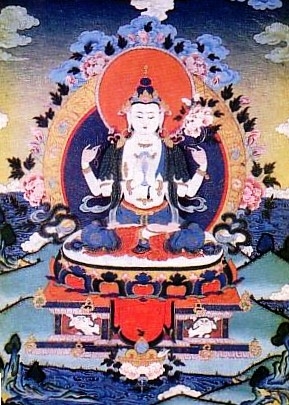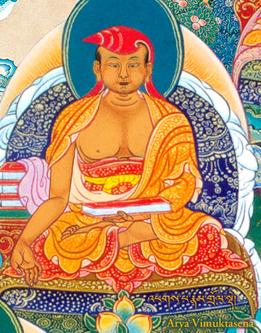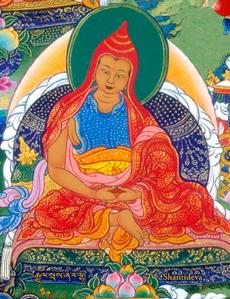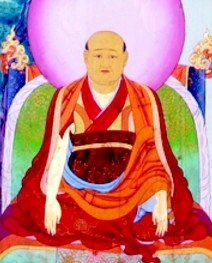Bodhichitta

Bodhichitta (Skt. bodhicitta; Tib. བྱང་ཆུབ་ཀྱི་སེམས་, chang chub kyi sem, Wyl. byang chub kyi sems) is the compassionate wish to attain enlightenment for the benefit of all beings.
Nature
| This section contains Tibetan script. Without proper Tibetan rendering support configured, you may see other symbols instead of Tibetan script. |
Buddhist scholars have debated whether bodhichitta is to be categorized as the 'main mind' (tso sem) or a 'mental state' (sem jung). Asanga and Vasubandhu were among those claiming it is a mental state, while Arya Vimuktasena and Haribhadra believe that it is the main mind. In his Light on the 25,000 Verses (Tib. ཉི་ཁྲིད་སྣང་བ་, nyi khrid snang ba), Arya Vimuktasena specifies that it is the mental consciousness (Tib. ཡིད་ཀྱི་རྣམ་ཤེས་, yid kyi rnam shes).
Definition

Literal Meaning/Etymology
Bodhi means our ‘enlightened essence’ and chitta (Skt. citta) means ‘heart’ or 'mind', hence the translation ‘the heart of enlightened mind’.
Scholarly Definitions
The most famous definition of bodhichitta appears in Maitreya's Abhisamayalankara:
|
This has twin aspects or purposes: 1) focusing on sentient beings with compassion, and 2) focusing on complete enlightenment with wisdom.
Khenpo Pema Vajra defines bodhichitta as "the wish to attain enlightenment in order to free all other sentient beings from the sufferings of existence and lead them to the unsurpassable bliss of omniscience."[2]
Khenpo Tsöndrü defines the generation of bodhichitta as "a special type of mental consciousness endowed with two aspects, inspired by the cause, longing to bring about the welfare of others, and accompanied by the support, longing to attain complete and perfect awakening."[3]
Divisions

Absolute & Relative
Bodhichitta is categorized into ‘relative’ or ‘conventional bodhichitta’, and ‘absolute bodhichitta’.
- Relative bodhichitta entails the compassionate wish to attain enlightenment for the benefit of all living beings and to train in the methods to achieve that aim.
- Absolute bodhichitta is the direct insight into the absolute nature of things.
Aspiration & Action
Within relative bodhichitta there is also the distinction between ‘bodhichitta in aspiration’ and ‘bodhichitta in action’, which is portrayed by Shantideva as the difference between deciding to go somewhere and actually making the journey:
|
|
The crucial importance of Bodhichitta
Patrul Rinpoche wrote:
- This arousing of bodhicitta is the quintessence of the eighty-four thousand methods taught by the Buddha. It is the instruction to have which is enough by itself, but to lack which renders anything else futile. It is a panacea, the medicine for a hundred ills. All other Dharma paths, such as the two accumulations, the purification of obscurations, meditation on deities and recitation of mantras, are simply methods to make this wish-granting gem, bodhicitta, take birth in the mind.
- Without bodhicitta, none of them can lead you to the level of perfect Buddhahood on their own. But once bodhicitta has been aroused in you, whatever Dharma practices you do will lead to the attainment of perfect Buddhahood.[5]
The Three Types of Commitment
(In The Words of My Perfect Teacher this is called Classification based on the three degrees of courage) (Three degrees of courage - Tib. བློ་སྟོབས་ཀྱི་ཁྱད་པར་གྱིས་དབྱེ་ན་གསུམ་ཡོད་དེ། Wyl. blo stobs kyi khyad par gyis dbye na gsum yod de)
- the king's way of arousing bodhichitta, with the great wish, is the intention to first attain Buddhahood oneself and then lead others to it. It is the least courageous of the three. (Tib. དང་པོ་རྒྱལ་པོ་ལྟ་བུ་ནི་འདོད་ཆེན་པོའི་སེམས་བསྐྱེད་ཅེས་བྱ་སྟེ་བློ་སྟོབས་ཐ་མ་ཡིན། Wyl. dang po rgyal pol ta bu ni ‘dod chen po’i sems bskyed ces bya ste blo stobs tha ma yin)
- the boatman's way of arousing bodhichitta, with sacred wisdom, is the intention to achieve Buddhahood at the same time as all sentient beings. It is more courageous. (Tib. གཉིས་པ་མཉན་པ་ལྟ་བུ་ནི། ཡེ་ཤེས་དམ་པའི་སེམས་བསྐྱེད་ཅེས་བྱ་སྟེ། བློ་སྟོབས་འབྲིང་པོ་ཡིན་ཞིང་། Wyl. gnyis pa mnyan pa lta bu ni| ye shes dam pa’i sems bskyed ces bya ste| blo stobs ‘bring po yin zhing|)
- the shepherd's way of arousing bodhichitta, beyond compare, is the intention to bring all beings to Buddhahood ahead of oneself. It is the most courageous of all ( Tib. རྫི་བོ་ལྟ་བུ་ནི་དཔེ་མེད་པའི་སེམས་བསྐྱེད་ཅེས་བྱ་སྟེ། ཤིན་ཏུ་བློ་སྟོབས་ཆེན་པོ་དང་ལྡན་པ། Wyl. rdzi bo lta bu’i dpe med pa’i sems bskyed ces bya ste| shin tub lo stobs chen po dang ldan pa)
Four Types of Bodhichitta According to the Paths and Levels
Bodhichitta can also be divided according to the five paths and ten bhumis:
- bodhichitta of aspiring conduct (Tib. མོས་པས་སྤྱོད་པའི་སེམས་བསྐྱེད་, Wyl. mos pas spyod pa'i sems bskyed ) (path of accumulation onwards)
- bodhichitta of pure noble intention (Tib. ལྷག་བསམ་རྣམ་དག་གི་སེམས་བསྐྱེད་, Wyl. lhag bsam rnam dag gi sems bskyed) (first bhumi onwards)
- bodhichitta of full maturation (Tib. རྣམ་པར་སྨིན་པའི་སེམས་བསྐྱེད་, Wyl. rnam par smin pa'i sems bskyed ) (eighth bhumi onwards)
- bodhichitta free from all obscurations (Tib. སྒྲིབ་པ་སྤངས་པའི་སེམས་བསྐྱེད་, Wyl. sgrib pa spangs pa'i sems bskyed ) (at the level of buddhahood)
There is also a division into twenty-two similes of bodhichitta, and the Sagaramatiparipriccha Sutra (Tib. བློ་གྲོས་རྒྱ་མཚོས་ཞུས་པའི་མདོ་, Wyl. blo gros rgya mtshos zhus pa'i mdo) mentions a classification according to eighty inexhaustibles which are discussed in Mipham Rinpoche's Khenjuk.
The Actual Training in Bodhichitta

Patrul Rinpoche says[6] that the training in bodhichitta has three elements:
- training in the cause by meditating on the four immeasurables,
- the actual training, which is to practise taking the vow of bodhichitta three times during the day and three times at night,
- and the training in the precepts, the meditations on equalizing and exchanging yourself and others, and consider others as more important than yourself.
The actual training in bodhichitta is to take the vow of bodhichitta by means of any formal practice—whether elaborate, medium or short—at the six times of the day and night, i.e., at dawn, mid-morning, midday, afternoon, dusk and midnight.
- 'Equalizing self and others’ means recognizing the equality of yourself and others in wishing to find happiness and wishing to avoid suffering.
- ‘Exchanging self and others’ means giving your own happiness to other sentient beings, and taking their suffering upon yourself.
- ‘Considering others as more important than yourself’ means setting aside your own benefit and accomplishing the benefit of others.
If you apply yourself to these practices, Patrul Rinpoche says, then you will never forget the mind of bodhichitta in all your future lives, and all the qualities of the bhumis and paths will develop and increase like the waxing moon.
Bodhichitta in Dzogchen
In a Dzogchen context, especially in the teachings of the category of mind, bodhichitta is used to refer to the awakened mind, or rigpa. In Chapter 12 of the Treasury of the Dharmadhatu[7], Longchenpa explains the literal meaning of bodhichitta in Dzogchen:
|
|
This is his commentary[8] on the verse:
|
|
Benefits of Bodhichitta
The Sutra The Questions of the Householder Viradatta praises Bodhichitta:
- If the merits of the resolve for awakening
- Were to assume physical form,
- They would fill the whole expanse of space
- And exceed even that.
- If someone were to fill with jewels
- As many buddha fields as there are grains of sand
- In the Ganges River,
- As an offering to the Protector of the World,
- This offering would be surpassed
- When someone with joined palms
- Directs their resolve toward awakening,
- Because that does not have a limit.[9]
The Sutra of the Arborescent Array sums up:
- In brief, the qualities and benefits of bodhichitta are as numerous as all the Buddha’s teachings and the qualities of buddhahood. Why is that? Because all the maṇḍalas of bodhisattvas arise from this, and all the tathagatas who have appeared in the past, those who will appear in the future, and those who are appearing at present, are born from this.[10]
In the Bodhisattva’s Scriptural Collection it is said:
- Shāriputra, if bodhisattva mahāsattvas possess one teaching, they will completely hold these teachings of the Buddha and infinite others. What is that one teaching? It is this: the perfect attitude that is the mind set on enlightenment. Shāriputra, if bodhisattva mahāsattvas possess this one teaching, they will completely hold these teachings of the Buddha and infinite others.[11]
Shantideva praises Bodhichitta in the Bodhicharyavatara as follows:
- It is the supreme elixir
- That overcomes the sovereignty of death.
- It is the inexhaustible treasure
- That eliminates poverty in the world.
- It is the supreme medicine
- That quells the world’s disease.
- It is the tree that shelters all beings
- Wandering and tired on the path of conditioned existence.
- It is the universal bridge
- That leads to freedom from unhappy states of birth.
- It is the dawning moon of the mind
- That dispels the torment of disturbing conceptions.
- It is the great sun that finally removes
- The misty ignorance of the world.[12]
Commentaries
Sogyal Rinpoche wrote:
- When you meditate deeply on compassion, a realization dawns in you that the only way for you to be of complete help to other beings is for you to gain enlightenment. From that a strong sense of determination and universal responsibility is born, and the compassionate wish arises in you at that moment to attain enlightenment for the benefit of all others.
- This compassionate wish is called Bodhichitta in Sanskrit; bodhi means our enlightened essence, and chitta means heart. So we could translate it as “the heart of our enlightened mind.” To awaken and develop the heart of the enlightened mind is to ripen steadily the seed of our buddha nature, that seed that in the end, when our practice of compassion has become perfect and all-embracing, will flower majestically into buddhahood. Bodhichitta, then, is the spring and source and root of the entire spiritual path.
Dzigar Kongtrul Rinpoche wrote:
- The purity of the wish to obtain enlightenment depends on two things: to what degree we have gotten rid of self-centeredness, and to what degree we are able to generate loving-kindness and compassion for others.
- The wish to be enlightened for the benefit of all mother sentient beings changes over time. It is not the wish itself that changes, but the quality of the wish changes tremendously. In the beginning the wish is not that authentic. It’s feeble and relatively easily destroyed by unfavorable circumstances. (..) By continuously practicing that wish over time, selfishness is brought to the surface and exhausted through the power of the training. The wish becomes more authentic and genuine, as loving-kindness, compassion, and sympathetic joy become very real and instinctive.[13]
Notes
- ↑ སེམས་བསྐྱེད་པ་ནི་གཞན་དོན་ཕྱིར། །
ཡང་དག་རྫོགས་པའི་བྱང་ཆུབ་འདོད། །Arousing bodhicitta is: For the sake of others,
Longing to attain complete enlightenment.
- ↑ ༈ གཞན་སེམས་ཅན་ཐམས་ཅད་སྲིད་པའི་སྡུག་བསྔལ་ལས་བསྒྲལ་ཏེ་ཐམས་ཅད་མཁྱེན་པའི་བདེ་བ་བླ་ན་མེད་པ་ལ་འཇོག་པའི་དོན་གྱི་ཆེད་དུ་བྱང་ཆུབ་ཐོབ་པར་འདོད་པ།, gzhan sems can thams cad srid pa'i sdug bsngal las bsgral te thams cad mkhyen pa'i bde ba bla na med pa la 'jog pa'i don gyi ched du byang chub thob par 'dod pa from Notes on Bodhichitta to Illuminate the Path of the Victorious One's Heirs.
- ↑
 The Words of Jikmé Chökyi Wangpo: A Commentary Presenting the Subject Matter of the Great Treatise, the Abhisamayalankara
The Words of Jikmé Chökyi Wangpo: A Commentary Presenting the Subject Matter of the Great Treatise, the Abhisamayalankara
- ↑ Bodhicharyavatara, I, 15 & 16
- ↑ The Words of My Perfect Teacher, page 221 (Yale University Press, Revised edition, 2010)
- ↑ Translation on Lotsawahouse:
 Patrul Rinpoche: Essential Refuge and Bodhichitta
Patrul Rinpoche: Essential Refuge and Bodhichitta
- ↑ see the Seven Treasuries
- ↑ Longchen Rabjam: A Treasure Trove of Scriptural Transmission (Skt. Dharmadhātu ratna koṣa nāma vṛtti; Tib. ཆོས་དབྱིངས་རིན་པོ་ཆེའི་མཛོད་ཅེས་བྱ་བའི་འགྲེལ་པ།, Wyl. chos dbyings rin po che'i mdzod ces bya ba'i 'grel pa), see the entry for Treasury of Dharmadhatu.
- ↑ https://read.84000.co/translation/UT22084-043-009.html#UT22084-043-009-128
- ↑ Shechen Gyaltsap, A chariot to freedom: guidance from the great masters on the Vajrayana preliminary practices, translated by the Padmakara Translation Group, Ch. 10 (Boulder: Shambhala, 2021)
- ↑ Ibid.
- ↑ Chapter 3, verses 29-32 (translation by Stephen Batchelor)
- ↑ Uncommon Happiness, The Path of the Compassionate Warrior, Ch. 8 Aspiration and Engagement, (Boudhanath, Hong Kong & Esby: Rangjung Yeshe Publications, 2009)
Canonical Litterature
Sutras
Further Reading
- Khunu Rinpoche, Vast as the Heavens, Deep as the Sea: Verses in Praise of Bodhicitta (Wisdom Publications, 1999)
- The Light of Wisdom, Volume 1. Root text by Padmasambhava and commentary by Jamgön Kongtrül the Great (Shambhala Publications), Chapters 12, 13 & 14, pages 115-155.
- Patrul Rinpoche, The Words of My Perfect Teacher, Chapter 2 (Yale University Press, Revised edition, 2010)
- Khenpo Ngawang Palzang,A Guide to the Words of My Perfect Teacher Part 2, Chapter 2, translated by Padmakara Translation Group (Boston & London: Shambhala, 2004)
